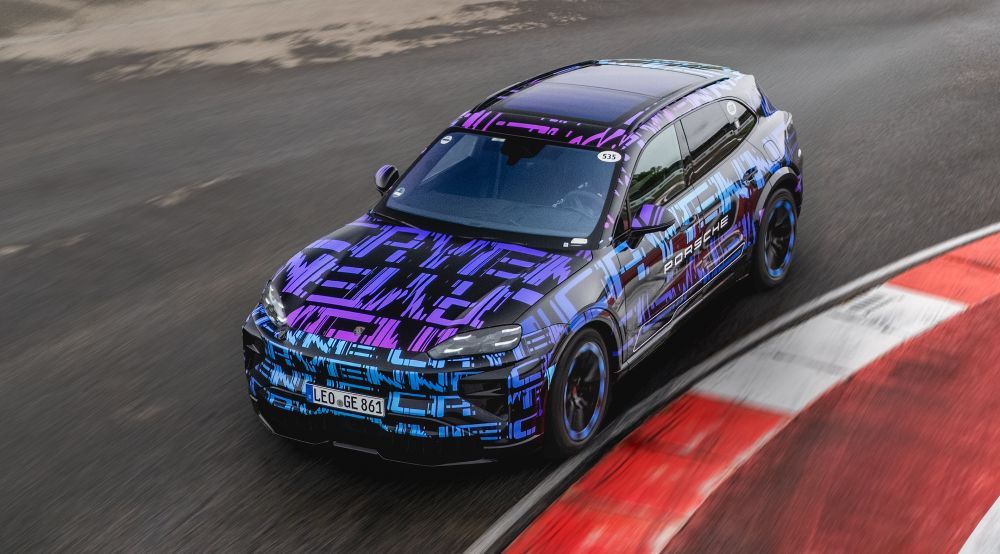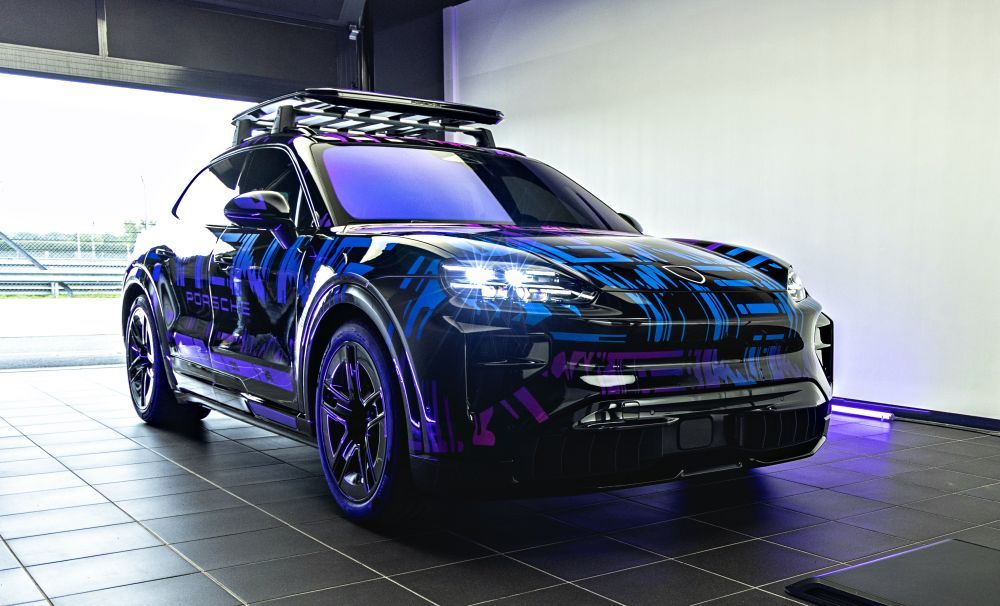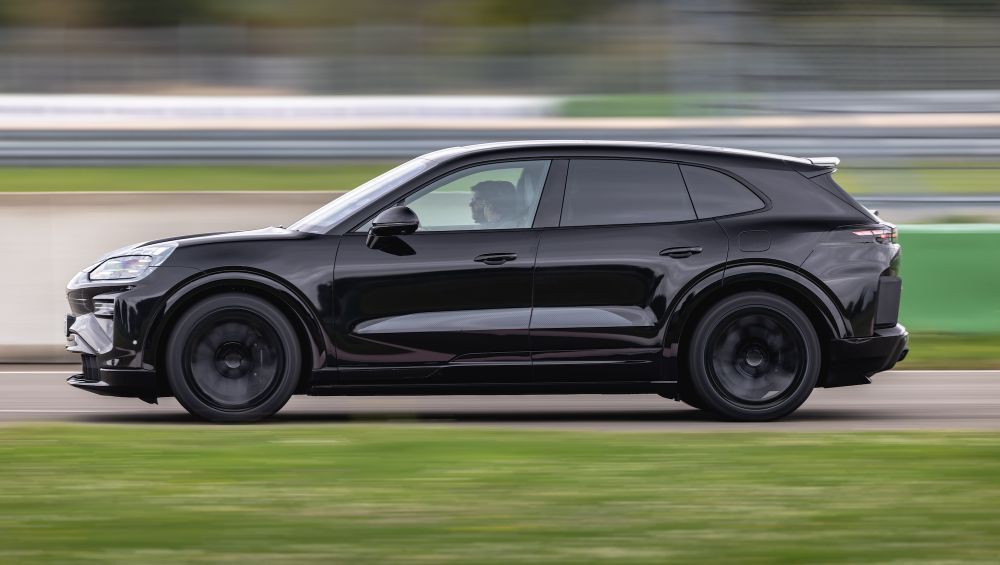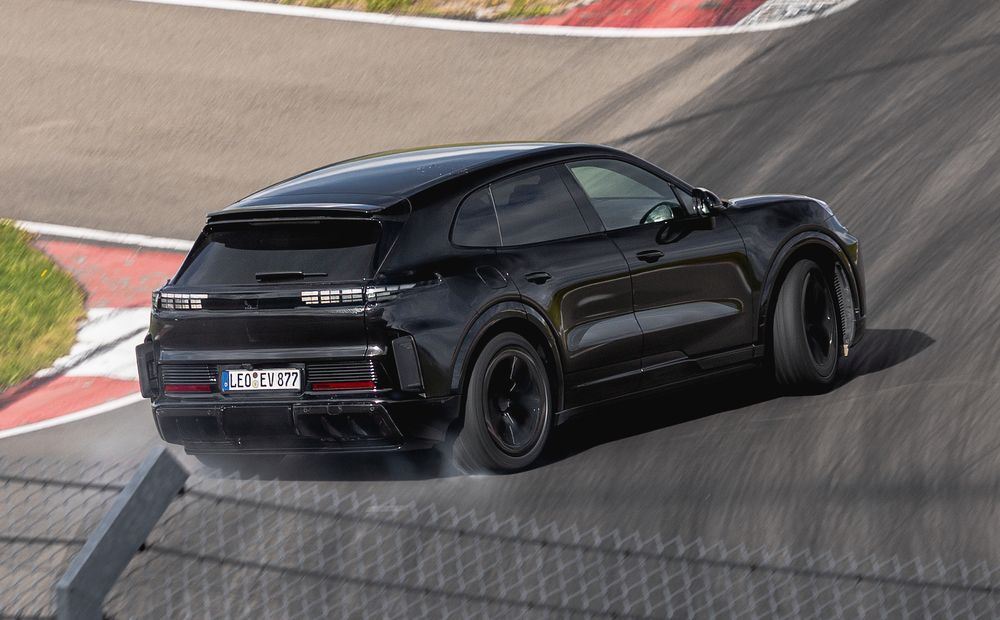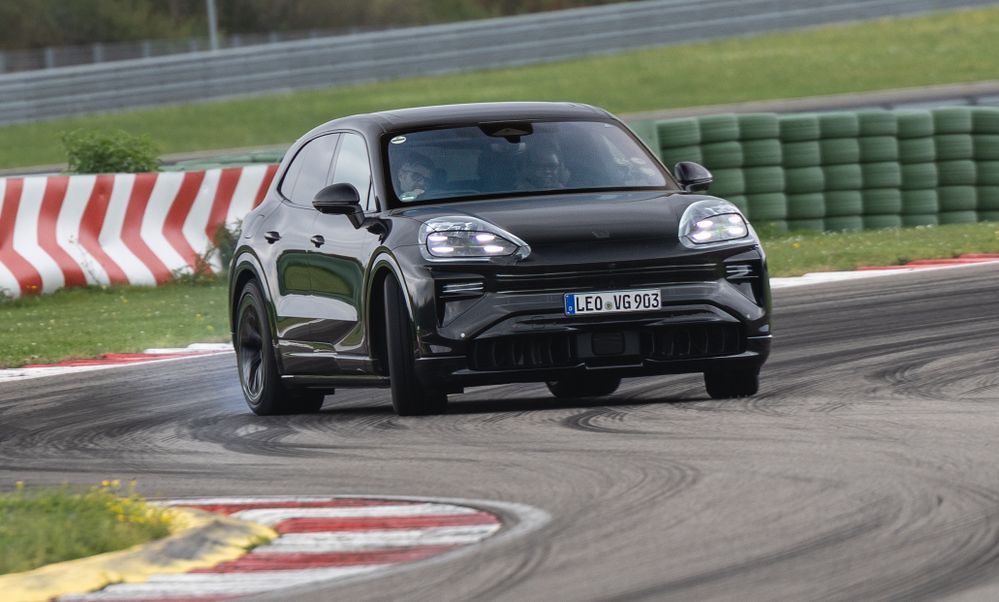Deep Dive: How Porsche Built The Ultimate EV That Just Happens To Be A Cayenne - A Look Into The Beastly E4
2 个月前
To be clear, after having the privilege of experiencing (but not driving) the new all-electric Cayenne in Germany, it did feel as close to anything to the appropriate use of the word ‘revolutionary’ next to other EVs I have sampled in the past few years. Some better than others, but most of which were obviously developed to fit a price point, not some absurd engineering goal. Well, except for the one stand-out: the Taycan.
Framed through this lens, I realised that this next-generation Cayenne is merely Porsche doing exactly what kept them so frustratingly undefineable - and untouchable - in the first place: relentless refinement and evolution, albeit behind the scenes. That said, on paper, this Cayenne is poised to be as disruptive as the thought of the brand behind the 911 making an SUV back in 2002.
Judging by their own benchmarks, it is a hugely ambitious undertaking and carries their bespoke EV technologies well beyond where they started on this path, but will that be enough to let this Cayenne live the transformative success its predecessors enjoyed? It isn’t without its naysayers, of which this writer did consider himself one.
First off, it has been well-established that Porsche has never been a company that rushes change. Every step it takes toward the future feels deliberate, measured, and more than a little unapologetic. When the brand launched the Taycan in 2019, back when I could barely pronounce it correctly, rather than just ‘enter’ the EV market to get its foot in the door, it was laying down a blueprint for what an electric Porsche should be: visceral, precise, and engineered to stir the ‘soul’, as its marketing slogan often repeated. They must’ve done more than a few things right, as no other EV four-door since has come close to being as brilliant behind the wheel.
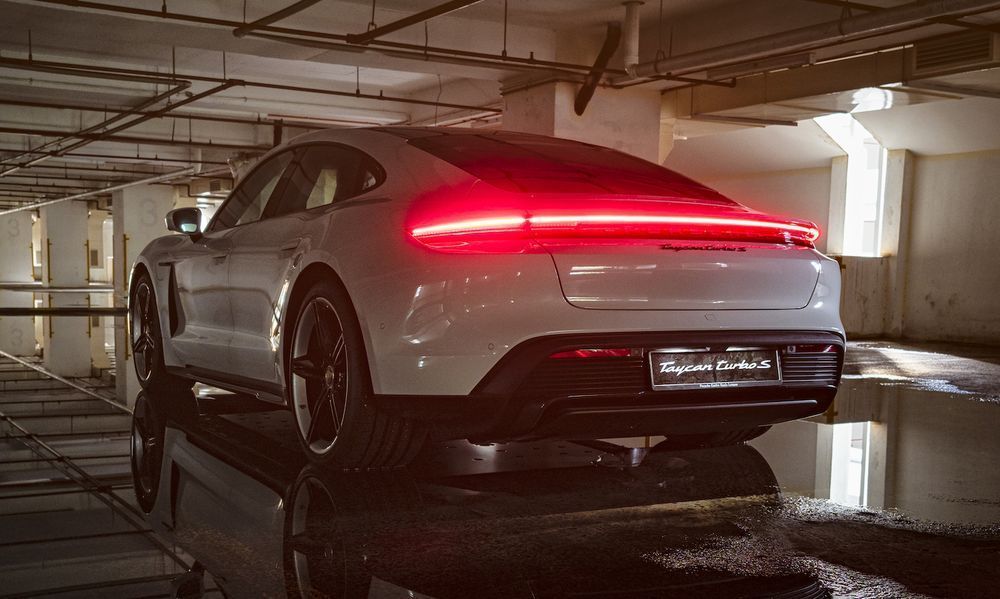
Now, half a decade later, Porsche stands on the brink of another defining moment, but one where the stakes are raised considerably. The icon that helped build its modern empire—the Cayenne—is about to undergo a complete reinvention. But should it?
Internally dubbed the E4, this all-electric SUV isn’t just a powertrain swap. It represents a total reimagining of what a high-performance SUV can be in the electric age, almost transcending the nameplate it has been asked to succeed. In some ways, and for the same reason why I felt it wise that the Taycan did not supplant the Panamera outright, I do continue to question whether the E4 should even be called a Cayenne.
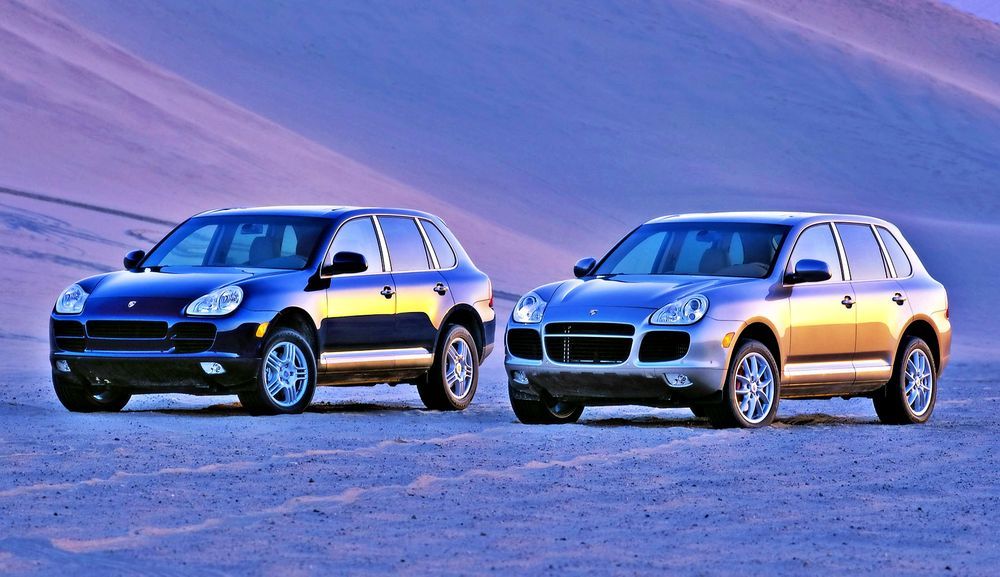
The original E1 Cayenne was once Porsche’s biggest gamble, the model that purists sneered at until it ended up saving the brand. Today, it’s the vehicle carrying the responsibility of tipping a critical mass (pun intended) of Porsche’s DNA into the electric era.
And if what we’ve seen from the technology workshops in Leipzig is any indication, the Cayenne E4 might just be Porsche’s most important, most technically dense vehicle since the that 2002 original, if not only for the sheer amounts of R&D crammed into it, many of which remain in-house and proprietary, but also for its lofty ambition that almost warrants its own unique beginning free of the nameplate’s tethers.

When Porsche launched the first Cayenne back in 2002, they weren’t trying to make friends—they were trying to survive. The math showed the company’s core lineup of sports cars couldn’t sustain long-term profitability, and the SUV boom was impossible to ignore. Yet, instead of creating just another luxury off-roader, Porsche engineered something extraordinary: a tall, heavy vehicle that somehow drove like a sports car on stilts.
Fast forward to 2025, and the Cayenne is no longer the underdog but a global bestseller that propelled Porsche to the top of the food chain, and eventually fund the development of the Taycan, the 918 Spyder, and countless flourishing projects. But now, it has been decided that the Cayenne itself must evolve to stay relevant. Or does it? The question remains, are we at a similar crossroad? Is this the right car for this moment?
Enter this Cayenne E4, the fourth generation and the first to run purely on electrons, sitting atop the new Porsche Premium Platform Electric (PPE) architecture, a joint development with Audi that also underpins the electric Macan. But where the Macan aims to introduce new customers to the Porsche EV world, the Cayenne E4 targets the core enthusiasts who expect nothing short of engineering brilliance.
While the full unmasking of the E4 is some time away, you can always tell a Porsche by its stance, and indeed the visual of a 'sport SUV' is one forever defined by this one brand. The proportions, the tapering roofline, the muscular haunches—these are the visible signatures that have anchored the Cayenne through decades of evolution, and no amount of distracting visual camouflage could hide that.
So when it came to designing the E4, Porsche’s challenge was simple yet profound: how do you make it look unmistakably Cayenne while making it uniquely electric? The answer, according to Porsche’s design team, wasn’t to reinvent the form but - wisely - to refine it. The E4 retains the commanding SUV silhouette of its predecessors but introduces a sleeker, more aerodynamic edge. The front fascia is dominated by a closed-off “shield” grille flanked by HD Matrix LED headlights—thin, precise, and sharply cut, inspired by the Taycan’s visual identity.
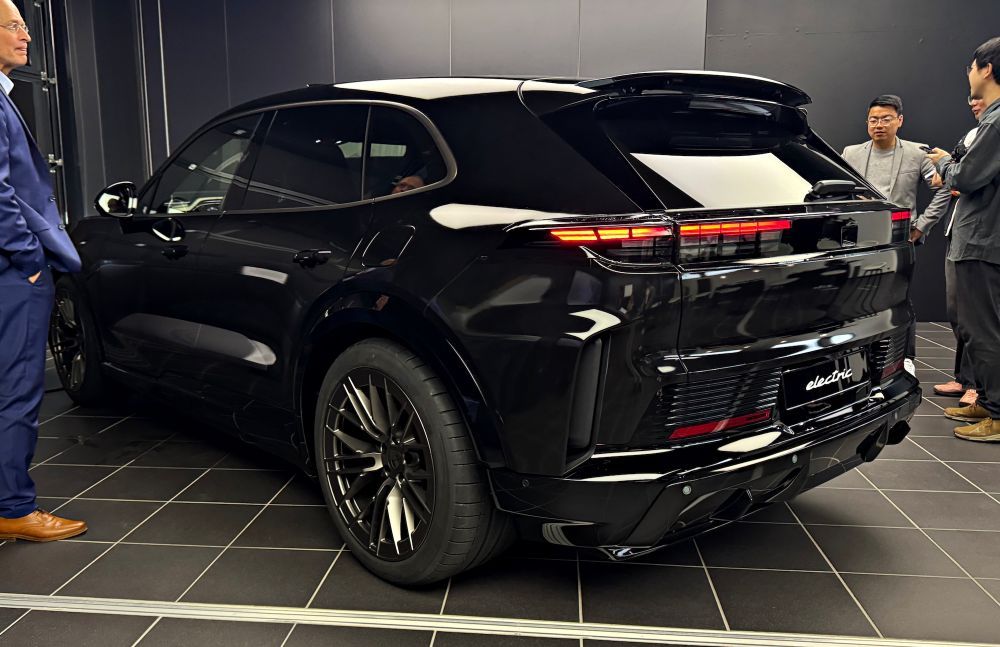
Every surface, vent, and crease serves a function. We both saw and were explained to how the front air curtains channels air along the flanks to reduce turbulence, while an active rear spoiler adjusts in real time to balance downforce and drag. The rear light bar, now a Porsche calling card after dusk, stretches across the tailgate with that crisp, Porsche “light signature” that glows like a single continuous beam—a design cue that signals both sophistication and a touch of menace.
Up close, through the shroud of a dark layer of wrap, it’s clear that the visual parallels that define the relationship between the original Type 95B Macan with the Cayenne of the period can be applied here with this and the Type XAB.
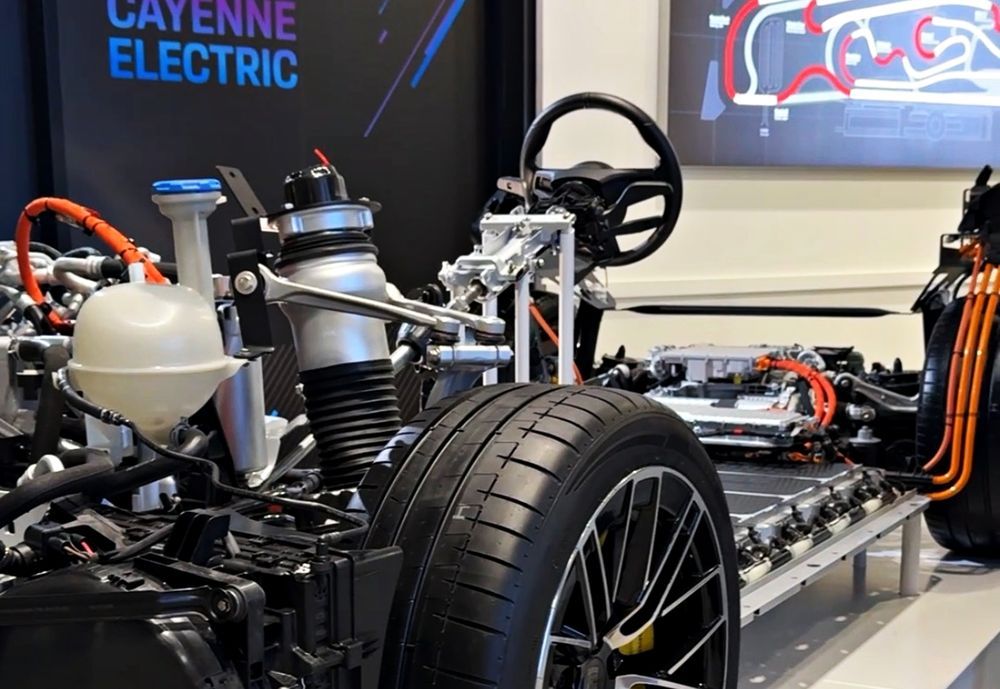
The beating heart of the new Cayenne E4 lies in its totally new dual-motor powertrain and a revamped 800-volt electrical architecture, elements that set a new benchmark for high-performance SUVs, electric or otherwise. Porsche says this setup isn’t just about raw numbers—it’s about control, response, and feel.
Each axle gets its own permanent magnet synchronous motor, tuned with Porsche’s signature rear-biased dynamics and power split. Sitting in the passenger seat for a standing start in an E4 felt absolutely brutal, viscerally more so than the Taycan Turbo GT that I drove just a day later, which is supposedly more even powerful and quicker in a century sprint. After having my guts pushed into my spine, I'm inclined to believe Porsche are underpromising.
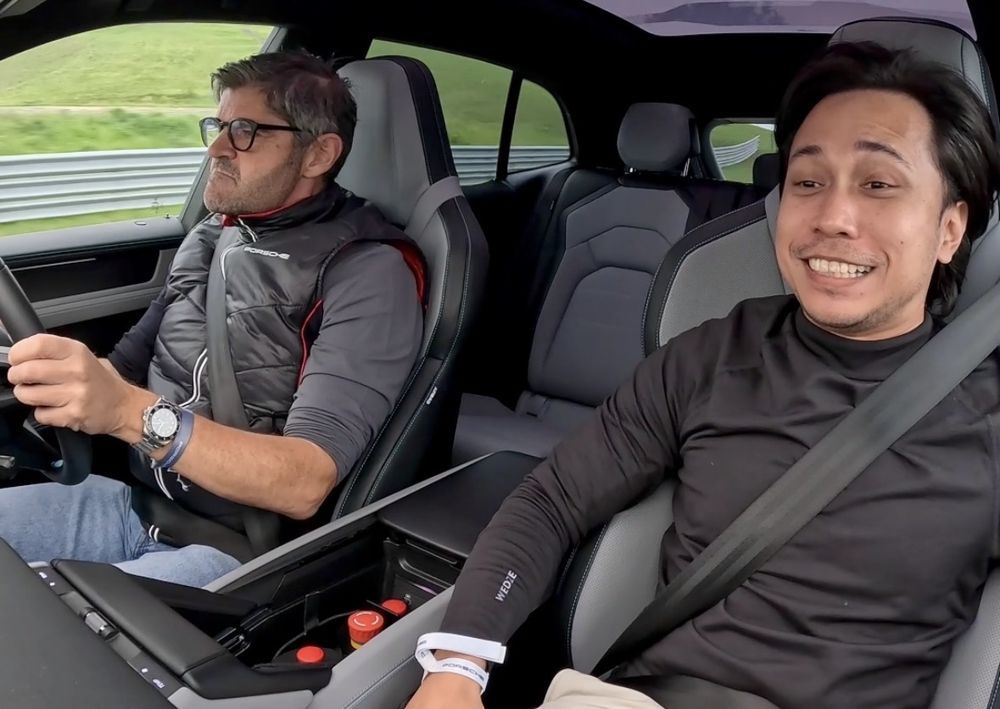
While they haven't officially released concrete performance or power figures, the Cayenne E4’s dual-motor is said to produce between 600 and 800 PS at the mid-level, depending on variant, and boast an expected a 0–100 km/h sprint in the 3-second range as well as something like 1,000 PS or more for the top-spec Turbo S.
But it’s the way it delivers performance that defines the experience. Instant torque doesn’t just fling you forward; it pushes you into a fluid, continuous surge of acceleration. There’s no hesitation, no time for reconsideration—just a clean, seamless rush of power that feels almost infinite.
More impressive still is the weight and inertia management. Despite tipping the scales well past two tonnes with its 130kWh battery (~113kW usable), the E4 masks its mass through sheer mechanical sophistication. Torque vectoring, rear-axle steering, and the battery’s lower-than-normal placement, all combine to make it dance through corners with improbable agility. Then also an extra ingredient, which we'll get into next.
At this recent Technical Workshop, Porsche demonstrated around their Leipzig test track how the Cayenne E4 could corner at speeds that would have passengers bracing for tilt, able to brake so late that it felt impossible to make the apex with the fluctuating masses at play, and turn-in so direct that it felt stapled to the blacktop, only for the SUV to remain eerily level through all this punishment. It’s a surreal sensation, and yet it never feels artificial, except perhaps for the synthesised soundtrack in lieu of a V8.
Porsche’s ‘Electric Sport Sound’ is probably the most realistic and pleasing version of an ‘engine note’ given to an EV, and its ethereal tones does put one in mind of a hyper-futuristic but soulful powerplant turning oxygen into an aural symphony by way of fire and brimstone, but we reckon you’d need to further suspend disbelief to receive the full effect. At least, more than I can muster.
Now THIS. A huge contributor to its physics-defying drive is the Porsche Active Ride, and it’s here’s where the Cayenne E4 truly separates itself from the rest of the EV world. Porsche’s latest and most advanced dynamic suspension system, which makes its debut in this Cayenne, isn’t just an iterative improvement, it’s a huge jump in ride control.
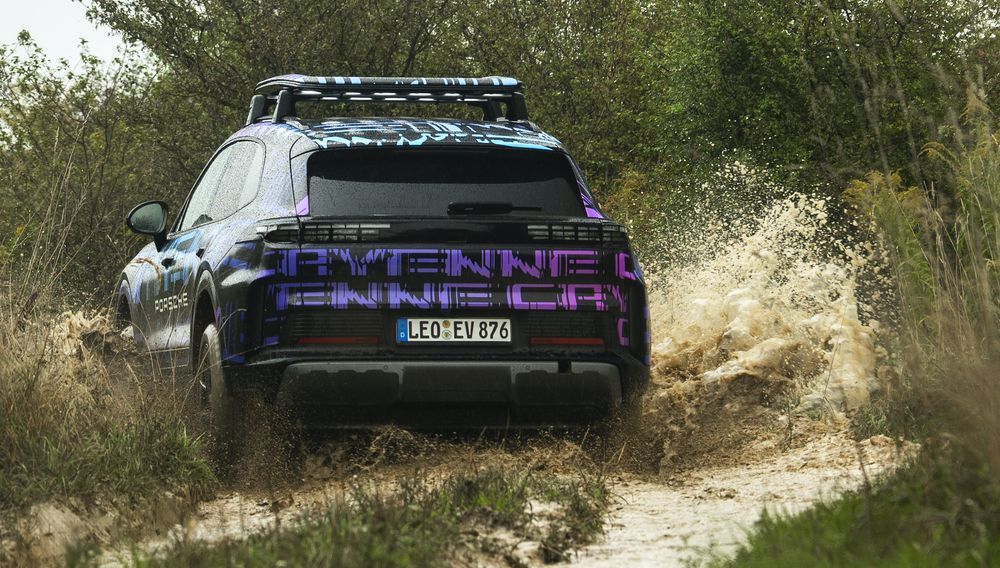
This system uses electromechanical hydraulic actuators at each wheel, themselves powered by a 400-volt subsystem to actively counteract body roll, pitch, and squat in real-time, effectively able to send extra spring rate to whichever corner needs it, and quicker than the blink of an eye.
In concept, it reminds me a lot of the Proactive Chassis Control (PCC) system fitted to the McLaren MP4-12C over a decade ago.
The result is a vehicle that stays perfectly, inconceivably composed through corners, acceleration, and braking—almost like it’s defying the laws of reality. To achieve this, Porsche’s new Active Ride system via the 4D Chassis Control 2.0 - essentially its real-time dynamics ‘brain’ - synchronises data from the steering, throttle, suspension, and braking systems every millisecond, allowing the Cayenne to “predict” what the driver is about to do and pre-adjusts its chassis behaviour accordingly.
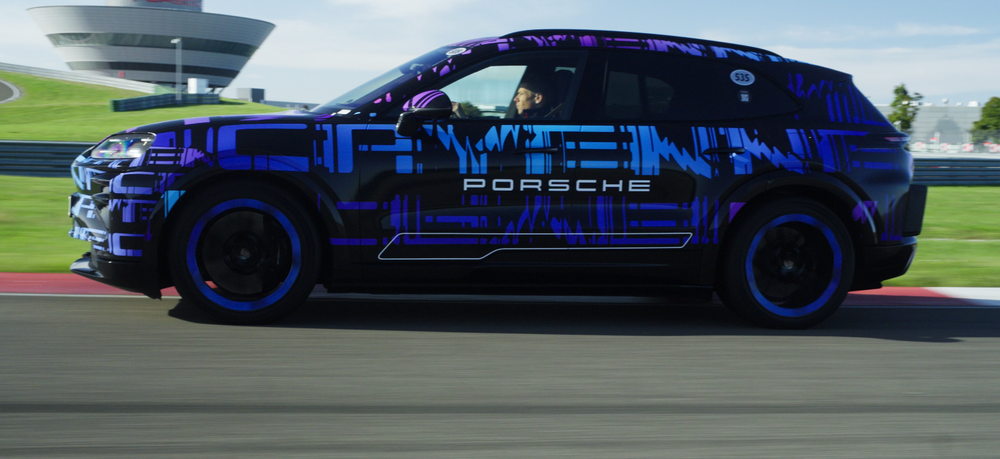
Here's where it gets a little geeky, but bear with me. Every EV lives or dies by its battery, and Porsche’s engineers know this better than most. The Cayenne E4 introduces a new-generation lithium-ion pack developed closely with partners LG with a usable capacity of around 113kWh.
Built using high-nickel prismatic cells, the battery promises a balance between energy density, charging speed, and thermal stability, able to perform at the highest loads those electric motors can demand of it for extended stretches, and yield 600km of range when fully topped up and driven responsibly.
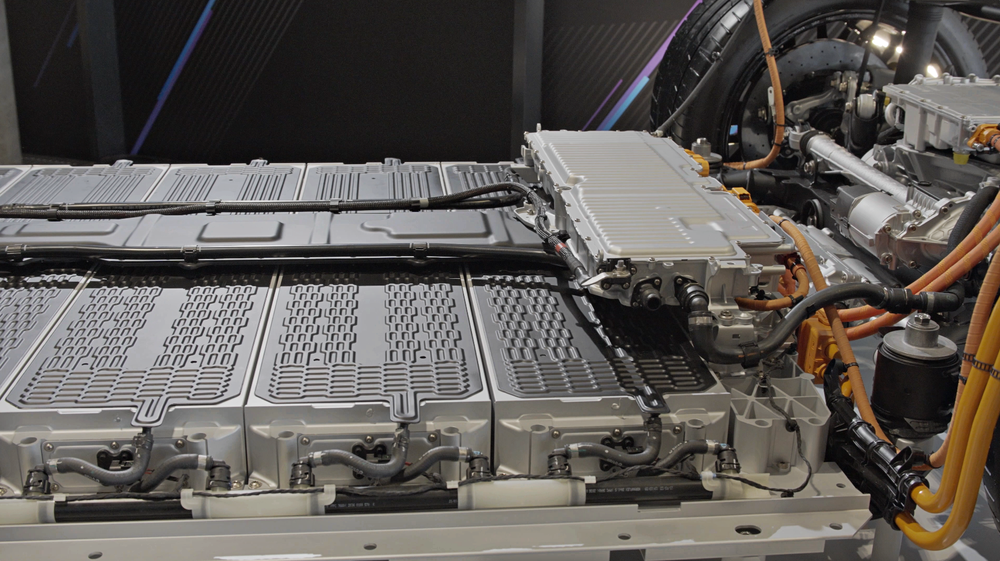
Thanks to the new PPE platform and the improved 800-volt system, the E4 can accept charging rates of up to 400 kW, replenishing from 10% to 80% in under 20 minutes, or 300km of range in 10 minutes, at a sufficiently rapid charger. Even the thermal management system has been thoroughly overhauled. The battery, motors, and power electronics share a multi-loop cooling circuit that constantly adapts based on driving style.
Go for a spirited highland drive, and the system prioritises cooling the motors; cruise on the highway, and it focuses on optimising battery temperature for maximum range. In typical Porsche fashion, every detail serves a purpose, and every purpose serves performance.
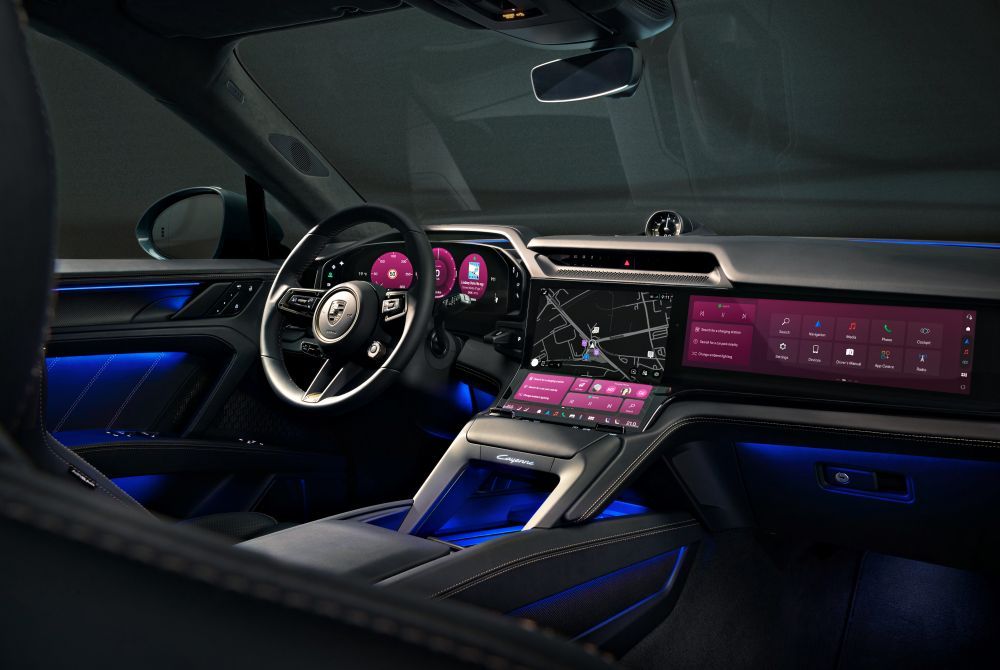
The technical workshop session in Leipzig more or less coincided with the brand’s global reveal of the Cayenne E4’s interior details, which prior to this were jealously guarded and covered up to outside eyes.
Step inside, and you’ll find a cabin that bridges the analog soul of a sports car with the creature comforts and conveniences we all expect, as well as a generous helping of design callbacks to the previous generations of Cayenne. The Porsche Driver Experience concept—first introduced in the Taycan and updated for the Macan EV—has evolved further in the Cayenne E4.
Directly in front of the driver sits a 12.6-inch curved digital instrument cluster, fully configurable with multiple driving modes and telemetry views. To its side, another curved 14.9-inch central infotainment OLED ‘Flow Display’ provides access to navigation, media, and vehicle settings while retaining much of the analogue ergonomics we all appreciate about past cars thanks to a raised ‘Ferry Pad’ on the centre console.
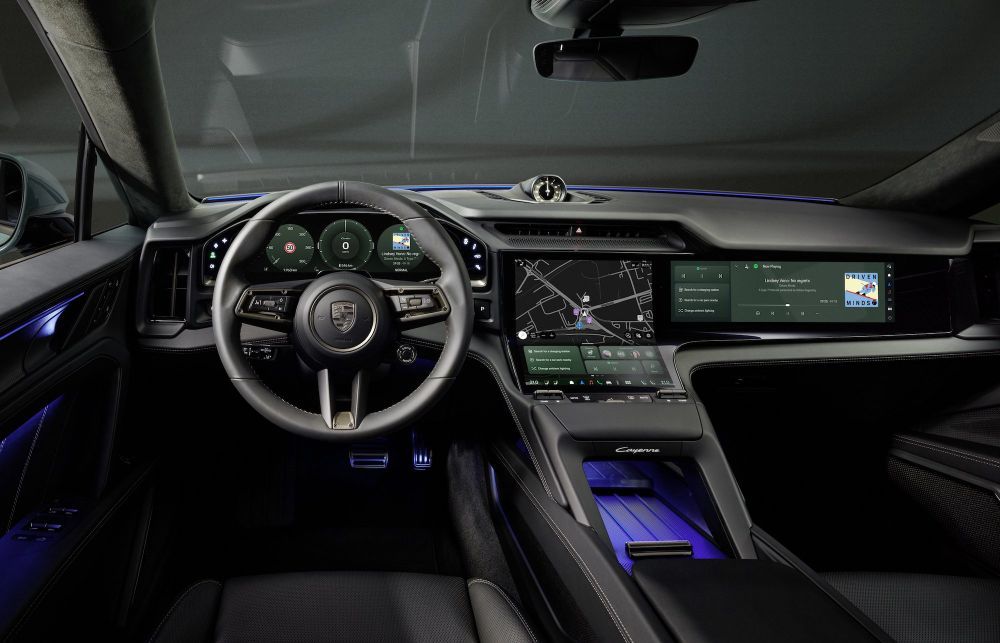
Yet despite all this technology, Porsche resisted the urge to go any deeper down the touchscreen rabbit hole. Physical toggle switches remain for essential functions like drive modes, suspension settings, and climate control—a decision that reflects Porsche’s respect for tactile interaction and how that contributes to the human-machine connection.
The steering wheel—911-derived, thick-rimmed, perfectly sculpted and Alcantara-wrapped - lead us to believe the static unit we were in was a Turbo S variant. The materials, as expected, are exquisite. Recycled leather alternatives are optional and open-pore wood trim coexist with sleek aluminium accents and soft ambient lighting, among many other buyer-configurable permutations. It’s luxury done the Porsche way—understated, sophisticated, with your choice of feel-good sustainable, or decadent toppings.
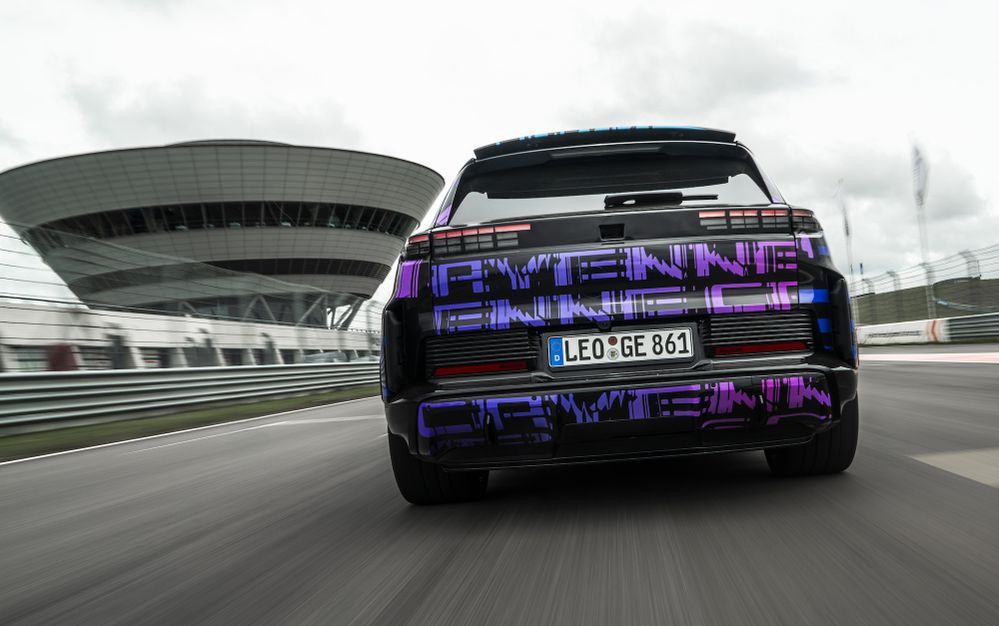
If the Taycan represented Porsche’s first confident step into electrification, the Cayenne E4 is the brand’s stride into maturity. This isn’t a compliance car or a side project, it’s obviously the product of years of refining electric technology to the point where it feels second nature to drive.
Porsche isn’t just electrifying the Cayenne; it’s redefining what an SUV can do if it leaned fully into all the mechanical, technological, conceptual, and dynamic advantages this powertrain format affords it. The combustion model gave the world the first true driver’s SUV. The electric version aims to prove that emotion and engineering can flourish in tandem.
We’ve only experienced the tip of this Cayenne’s proverbial iceberg, and if the Taycan was the very talented tip of the spear, the E4 is feels like arrowhead attached to sledgehammer. As the automotive world accelerates into some balance that includes an electric future, Porsche’s message remains crystal clear: emotion still matters, even when powered by silence.
]]>...Read the fullstory
It's better on the More. News app
✅ It’s fast
✅ It’s easy to use
✅ It’s free


